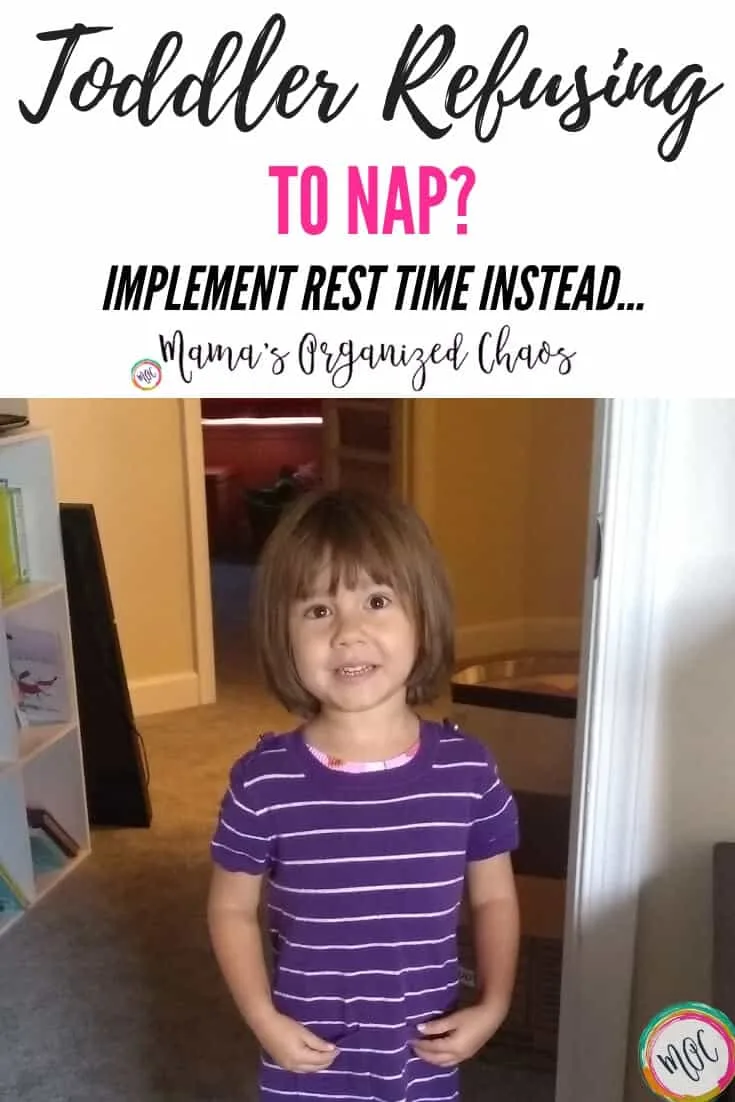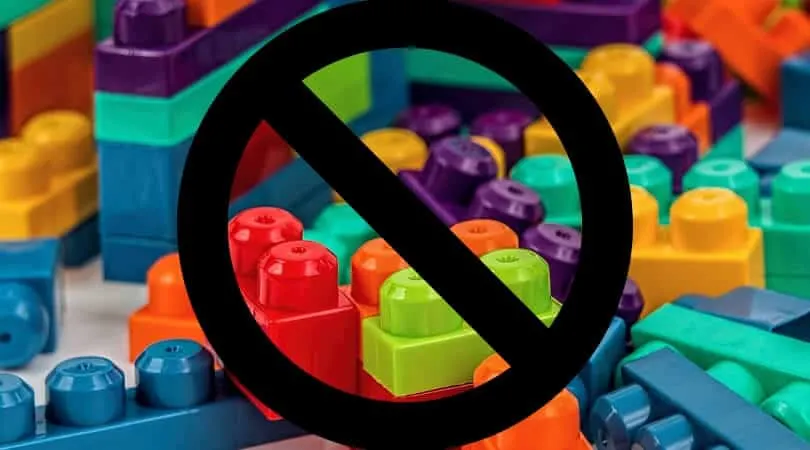So, your toddler refuses to nap? You think they might be ready for dropping the nap all together…but you are wondering when to make the switch, how to make the switch, and what the result might look like?

You’ve come to the right place.
In this post, I’ll be discussing what rest time looks like for our toddler.
Before transitioning to rest time, however, I encourage you to read these two posts on dropping the last nap in preparation:
- Click here to read “When Do Toddlers Stop Napping?” and find out if your child is ready.
- Click here to read “Toddler Won’t Nap? How to Make the Transition to Rest Time”
Then make your way back here and read about what Rest Time Rules should be!
We implemented rest time rules when our daughter was 2.5 years old. I knew full well that she was simply in a phase, and not ready to officially drop her nap.
I also wasn’t ready for that glorious toddler nap to be gone. I needed the quiet time for me as well!
Our daughter did, however, need a really big change to happen, because she was fighting the nap and it had suddenly become a battle.
Minor toddler nap time battles happen, but we had entered a massive battle phase that I just couldn’t take any longer.
And so, we took the pressure off of nap time, while enforcing rules that would cater to naps and rest time- whichever she felt she needed on a specific day.
Find Printable Parenting tools at our Etsy Shop:
no productsThe reality is that we can’t force our children to sleep. We can set them up for success, and provide them guidance and structure.
But at the end of the day, all we can do is put them down for a nap and just cross our fingers that they actually sleep.
The second reality is that children go through phases. Nap strikes happen and it doesn’t mean that naptime isn’t going to be needed again at some point soon.
It simply means that right now, your toddler might be excited about new skills and things they are learning, or maybe are just packed full of energy for some reason.

It could just be a sleep regression, which is temporary and not worth dropping afternoon naps over.
Next week, however, they might be as tired and cranky as can be, and really need their nap back.
If the nap time has been dropped completely, and no rest time or quiet time put in its place, then it will be a struggle to re-implement naps.
As a result, we kept things structured, yet flexible. Our rules can cater to a nap, but they can also cater to rest time.
Toddler sleep is so important to keeping kids happy throughout the day. One afternoon nap, along with good toddler sleep can be the difference between a child that throws fits all day, verses one that is happy.
The sleep time provided during the day, can be the difference between a child sleeping well at night, or being overtired and struggling at bedtime.
The best part about our rest time rules, is that it gives our toddler the power to choose what is right for her.
It takes the pressure off of sleeping. And no matter which choice she makes, she will be resting.
That means it’s a parenting win. I only give her the ability to do things that I am ok with (nap or rest time). She’s set up for restful success either way.
And so, our rest time rules were invented…
Tips for parents: Keep your routine before nap the same. Even during what we call rest time, we close the curtains, and turn her sound machine on.
These little parts of the routine help to keep consistency for our children. Consistency provides comfort.
Odds are, your new rules will be much better received if there is consistency with the routine you’ve always had as well.
Rest Time or Quiet Time Rules:
1. Stay in bed until the My Tot Clock is yellow
This clock has been by far the best purchase we’ve ever made. It’s helped with early morning wakings, nighttime expectations, and naps.
Now, here it is being incredibly helpful with rest time.
We made a tiny change. Instead of turning the clock blue for nap time, we turned it green. We told her green is for big girl rest time.
This was so exciting to our 2.5 year old! She loves doing anything big girls get to do!
That right there, took the pressure off of napping and made it exciting to her.
The color might be different, but the expectation is the same. Stay in bed until the clock turns yellow.
She’s understood that since she was 1.5 years old, so it was just a continuation of a good solid rule.
Stay in bed.
I don’t care if you sleep or rest.
Stay in bed.
No pressure.

2. Three Books and Three Stuffed Animals

Our daughter is allowed to have 3 books on her nightstand. She is also allowed to have 3 stuffed animals in bed.
This gives her something to do for her “rest time activities” and quiet play if she so chooses. But it isn’t too much that she is distracted, overwhelmed, and over stimulated.
She’s also allowed to switch these out, now that she’s older. So, she can get up during rest time to change out one of her books, and then get right back in bed.
This rule has worked incredibly well.
3. No toys

No toys are needed for rest time. Quiet play is best achieved with quiet things.
For our daughter, books and stuffed animals gives her that quiet time without being too stimulating.
She does some pretend play with the stuffed animals, and she “reads” or looks at her books.
It’s a perfect amount of stimulation to keep her happy, yet in a restful, quiet state.
4. Quiet Play (in bed) or sleep
We have always reminded her, that just because it’s now called “rest time”, and her clock is green instead of blue, doesn’t mean she can’t sleep.
We remind her that she is allowed to have her quiet play in bed, and that she can also sleep if she feels tired. Either is ok!
Our daughter is now 1 month away from turning 4. There are weeks that she doesn’t nap much at all, and she simply does rest time.
There are weeks that she naps every day and I have to wake her up so she doesn’t sleep too long.
And there are weeks that she both naps and rests equal amounts.
She tends to know what she needs and has done really well with doing exactly that.
As a result, we have a super happy, well rested child.
There is going to come a day soon, however, that I will have to change up the above rules in an effort to guide her away from naps. Although I’m going to wait as long as possible!
Why guide her away from naps?
Two reasons:
- Kindergarten will force our hand (although luckily we have a long time before this since she has a November birthday and an extra year).
- Bedtime is equally important. Her nighttime sleep is impacted as a result of her one nap.
Her bedtime is 7:30 pm. I don’t want this to get pushed much later. On the days she naps, however, she is wide awake in bed for quite awhile before actually falling asleep.
I want to make sure this awake time in bed (before she goes to sleep at night) doesn’t get to be too long for her to handle.
If it does, I’m going to throw another change at her for “rest time rules”:
She’ll be allowed room time in it’s place. The difference being that instead of having to stay in bed, she’ll simply get to have quiet play time in her room.
If she feels like it, she can get in bed and nap.
I’m guessing it will excite her enough to keep her playing in her room for a bit, and only on the days she’s super tired, will she actually nap.
I think this next step will be the perfect transition to the removal of naps completely, and working towards the removal of rest time before she enters the full time load of Kindergarten.
